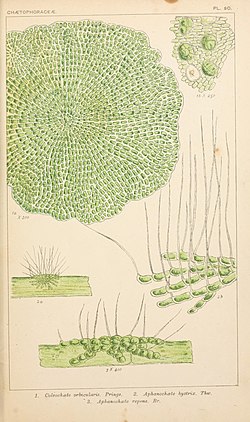| Coleochaetophyceae | |
|---|---|
 | |
| Coleochaete sp. | |
| Scientific classification | |
| Domain: | Eukaryota |
| Clade: | Archaeplastida |
| Clade: | Viridiplantae |
| Division: | Charophyta |
| Class: | Coleochaetophyceae C.Jeffrey [1] |
| Orders | |
Coleochaetophyceae is a class of charophyte algae related to land plants (only Zygnematophyceae is closer). [2] There are about 35 known species, and are predominantly found in freshwater where they live periphytic on the surface of aquatic plants, plastic bags and pebbles in the shallow littoral zone of freshwater lakes. [3] [4] These are small (<200 μm) disc-shaped or filamentous species, and have true multicellular organisation with sexual and asexual reproduction. The discs never develop beyond a two-dimensional organization. [5] Their mitogenome is the most intron rich organelle among the streptophyte algae. [6]
The group contain two orders, Coleochaetales and Chaetosphaeridiales. [1]